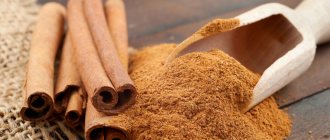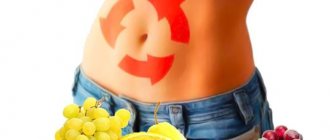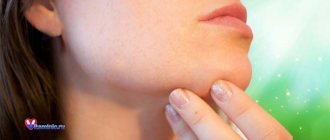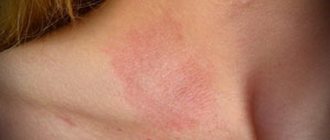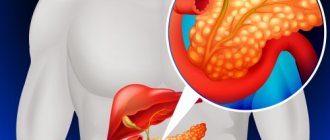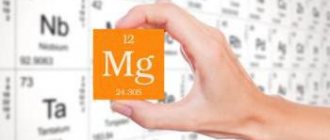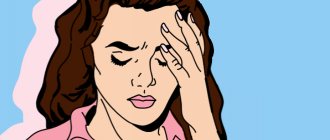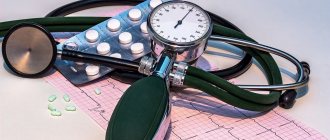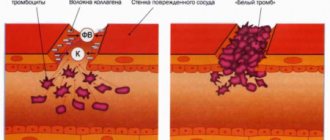Are you constantly tired? Don't get enough sleep? Can't concentrate even on simple tasks? Your body may not have enough iron. According to the World Health Organization (WHO), approximately four billion people suffer from iron deficiency. In Europe alone there are about 50 million such patients. However, most of them can be completely cured.
Like 14
22436
Iron is a vital trace element in the human body. The main amount of iron is part of hemoglobin. However, iron is necessary not only for normal hematopoiesis, but also for a number of other vital processes occurring in the human body, such as the production of hormones and, ultimately, the production of cellular energy - that is, simply put, vital energy.
Normally, our body gets iron from food and stores it in the form of a special compound called ferritin. The body uses it primarily to produce hemoglobin.
- 288 210
More details - 162 148
More details
- 540
More details
- 935 888
More details
When ferritin reserves approach a minimum, the level of hemoglobin, which can be determined using standard medical tests, remains within the normal range for a long time, while in fact, iron deficiency may make itself felt.
How to determine iron deficiency in the body?
When there is a deficiency of microelements in the body, typical symptoms appear, which give reason to consult a doctor and conduct a blood test. Lack of iron in the body is determined by the level of iron-containing protein in the blood - hemoglobin. When its level drops below 120 g/l in women and 130 g/l in men, a diagnosis of iron deficiency in the body can be made. The analysis is carried out on an empty stomach in the morning. The day before, you should not eat fatty foods or drink alcohol. An hour before the study, smoking and physical activity are prohibited.
Lack of iron in the body - symptoms
The most common signs that the body requires additional iron are:
- pallor of the skin, mucous membranes (can be seen on the lower eyelid);
- feeling of shortness of breath and rapid heartbeat with weak physical exertion;
- dizziness and headache;
- increased irritability and fatigue;
- sleep and appetite disorders;
- desire to eat chalk, clay, spicy and salty foods;
- cracks in the corners of the mouth, difficulty swallowing dry food;
- brittle nails, dry skin and hair loss.
Women experience signs of iron deficiency in the body during pregnancy, with heavy menstruation. With increased loads in athletes, with the rapid growth of children and adolescents, the need for a larger supply also increases, so these categories belong to risk groups and they require mandatory laboratory monitoring of blood hemoglobin levels.
Causes of iron deficiency
Symptoms of iron deficiency are called anemia. This is possible when its consumption increases or when there is a lack of supply.
In women, a lack of iron in the body is observed for the following reasons:
- blood loss due to heavy menstruation;
- diseases of the reproductive system, most often the uterus;
- puberty;
- abortions;
- pregnancy;
- childbirth;
- surgical interventions;
- breast-feeding;
- internal bleeding in the stomach and intestines;
- increased energy expenditure when playing sports;
- eating habits;
- avitaminosis.
A lack of iron intake is observed in the body of vegetarian women, raw foodists, and supporters of weight loss diets. This is facilitated by a sharp change in diet, lifestyle changes, and improper fasting.
Iron deficiency in women can also occur during normal intake of iron into the body, when its absorption is impaired.
When iron is poorly absorbed
Iron in women is poorly absorbed in the body for the following reasons:
- gastrointestinal diseases: increased acidity, pancreatitis, gastritis, enterocolitis;
- lack of vitamins that promote the absorption of iron: C, B12, folic acid;
- with excessive amounts of substances that interfere with the absorption of iron: oxalates, calcium, zinc, phosphorus, vitamin E;
Why is iron not absorbed? The reasons may lie in poisoning. To neutralize them, the liver produces enzymes, which also include iron. Also, symptoms of iron deficiency are observed with hypothyroidism (lack of hormone production by the thyroid gland). The cause of low microelement levels may be working in unfavorable, dangerous conditions.
https://youtu.be/kdSLLH1EIlU
Causes of iron deficiency in the body
When intake from food decreases, absorption into the blood from the digestive system is impaired, or bleeding occurs, the iron content in the body decreases. An iron level in the blood below normal occurs when:
- monotonous diet of fats and carbohydrates, among vegetarians;
- gastritis, peptic ulcer;
- pancreatitis;
- intestinal diseases - enterocolitis, dysbacteriosis;
- infection with worms;
- blood loss due to erosions and ulcers of the gastrointestinal tract, hemorrhoids;
- after extensive operations and injuries, childbirth;
- with heavy menstrual bleeding;
- for oncological diseases.
With long-term use of medications that impair the transport of iron from food, drug-induced anemia may develop. This is a group of antacid drugs that reduce the production of hydrochloric acid in the stomach, antibiotics, sulfonamides, calcium preparations. Chronic inflammatory processes in the body and lung diseases can cause a decrease in hemoglobin in the blood.
What is the normal iron content?
For a woman’s body, the iron content in the blood should be 8.95-30.43 µmol/l. A healthy body should contain 3.5-4.5 g of iron. The daily requirement is 18 mg. During pregnancy and lactation, the daily norm in a woman’s body doubles.
Daily iron requirement table
| Patient group | Requirement, mcg/kg | Content in food, mcg/kg | Availability/need ratio |
| Infants | 67 | 33-66 | 0,5-1 |
| Children 1-12 years old | 22 | 48-96 | 2-4 |
| Girls | 20 | 30-60 | 1,5-3 |
| Boys | 21 | 30-60 | 1,5-3 |
| Adult women | 21 | 18-36 | 1-2 |
| Adult men | 13 | 26-52 | 2-4 |
| Pregnant women (II-III trimester) | 80 | 18-36 | 0,22-0,45 |
When there is a shortage or excess of a microelement in a woman’s body, disorders occur.
Iron loss
A woman’s body loses a certain amount of iron every day. Typically, the loss is about 1 mg. Iron is excreted in bile, urine, and then. During menstruation, iron loss is 45-90 mg.
Average daily iron loss table
| Patient category | Norm (mg) |
| Men and non-menstruating women | 1-2 |
| Women aged 15-50 years | 2-3 |
| Women during pregnancy | 1-2 |
| 1st trimester | 5,5-6 |
| 2nd trimester | 5-6 |
| III trimester | 11,5 |
| Women during lactation | 2-5 |
Consequences of excess iron in the blood
If there is enough iron in the foods you consume, you cannot allow an excess of this microelement. What does excess iron lead to? The consequences of excess iron are as follows:
- cirrhosis of the liver;
- arthritis;
- diabetes;
- hepatitis symptoms;
- liver or stomach cancer;
- iron poisoning;
- symptoms of abnormalities in the functioning of the nervous system;
- muscle fiber ruptures.
Symptoms of iron overload are similar to those of hepatitis. The main symptom is yellowness of the skin and sclera.
An excess of iron is possible if there is iron in drinking water, after a blood transfusion, or long-term use of iron-containing drugs.
What are the dangers of iron deficiency in the body?
With a chronic lack of oxygen, the activity of the heart is disrupted - arrhythmias, heart failure, the activity of the brain worsens - memory and intelligence weaken, irritability and depression appear. Iron deficiency in the body reduces immune defense, infections are more severe and often recur. In old age, the risk of developing heart attacks and strokes increases. Anemia in pregnant women threatens to disrupt the formation of organs and systems of the fetus and delay the child's development.
Headache
An organism that lacks iron will automatically give all available oxygen first to the brain, and the remainder will go to other organs and tissues. But even in this case, the brain will still receive less nutrition than it should. As a result, the arteries of the brain dilate, causing headaches.
218 years ago, Richard Trevithick demonstrated the first steam car (photo)
Police cars in Nagpur turn into safe taxis for women at night
DNA tourism is trending: demand for trips to places of origin is growing
Daily iron requirement for women
Women of childbearing age need to get 15-20 mg of iron per day from food, during pregnancy and lactating - up to 30 mg. For women at the onset of menopause, the iron requirement per day is only 8 mg. Iron (20-35%) is most easily absorbed from animal products, because it is part of the same hemoglobin. From plant foods, the percentage of absorption is lower - from 2 to 15%. Ascorbic acid and B vitamins help the absorption of iron, and calcium from dairy products, tannins in tea or coffee, and alcohol inhibit it.
What is anemia
Anemia is a decrease in the content of hemoglobin and red blood cells in the blood. It is caused by various factors - congenital or acquired disorders of the formation of red blood cells or hemoglobin, destruction (hemolysis) of cell membranes under the influence of poisons, blood loss.
The vast majority of cases of the disease are associated with iron deficiency . Clinical manifestations of anemia are caused by insufficient oxygen supply to the tissues. Symptoms are not always obvious - general weakness, dizziness, pale skin. Therefore, blood tests are necessary for diagnosis.
Treatment includes dietary nutrition with increased intake of foods rich in iron, medications, and in special cases, intravenous administration of red blood cells is necessary.
We recommend reading the article about transferrin analysis. From it you will learn about the functions of protein, indications and contraindications for taking the test, preparing for a biochemical study, and the reasons for the increase and decrease in transferrin. And here is more information about blood hemolysis.
How to compensate for the lack of iron in the body?
It is imperative to treat the cause that caused iron deficiency. Vitamin complexes with microelements will help compensate for the lack of iron in the initial forms of anemia or prevent it. The best and safest way to get iron is a properly formulated diet, which includes:
- ensure sufficient protein content (meat, fish, seafood, beef liver);
- limit animal fats (lard, pork, lamb);
- include more foods with vitamins B and C (legumes, bran, lemons, black currants);
- reduce dairy products, tea and coffee.
If preventive measures are ineffective and in severe cases of the disease, iron-containing drugs are prescribed in tablets or injections. The most common remedies are Aktiferrin, Ferrum Lek, Sorbifer Durules, Totema. Iron supplements are difficult to tolerate when taken and have many contraindications, so they are taken under the supervision of a doctor.
Vitamins with iron for women
To prevent iron deficiency (in the absence of severe diseases), multivitamin complexes with microelements are used. Their composition is balanced in such a way that iron can be fully absorbed. For women, it is best to choose vitamins that meet the daily requirement. Optimal vitamins containing iron:
- AlfaVit Classic (14 mg iron);
- Vitrum (18 mg);
- Complivit Iron (15 mg);
- Centrum A to Zn (18 mg);
- Teravit (27 mg);
- Multi-tabs(14 mg)
- Elevit pronatal (60 mg) and Vitacap (50 mg) for pregnant women.
Most often, multivitamin complexes are prescribed one tablet per day for a month of use. They must be taken after meals and washed down with half a glass of water. For children, special complexes are produced in the form of chewable tablets or jelly with fruit flavor: Jungle with minerals, Naturetto, Complivit Active. After a month of taking it, the blood test must be repeated, because an overdose of iron is no less dangerous than a deficiency.
Which foods have the most iron?
The best sources of absorbable iron are beef, pork, and chicken liver. Foods rich in iron must be on the menu for anemia: veal, beef, turkey, mussels, egg yolk. There is also a lot of iron in plant foods: lentils, beans, tofu, pumpkin seeds, buckwheat. Legumes need to be soaked before consumption to reduce the concentration of phytic acid, which inhibits the absorption of iron. Apples and pomegranates, used to raise hemoglobin, contain little iron. The most beneficial for anemia are blueberries and apricots, prunes and dried apricots.
Lack of iron in the blood - diet
Diet therapy for anemia, in addition to saturating the body with iron, should provide the body with complete proteins, vitamins and beneficial microelements. Be sure to eat meat products, lots of green vegetables and fruits. Iron deficiency can be corrected with the following sample menu:
- for breakfast - oatmeal and dried apricots, blueberry jelly.
- for second breakfast - bran bread, cheese, blackcurrant compote.
- For lunch - lentil soup, chicken liver, salad, tomato juice.
- For dinner - jellied fish, buckwheat porridge, beet salad with lemon juice, herbs, rosehip infusion.
In addition to diet, traditional medicine is also used to treat iron deficiency in the body. Honey, aloe, pollen, sprouted wheat, rose hips, St. John's wort and blackberry leaves are good for treating anemia. For women with heavy periods, nettle, raspberry leaf and yarrow herb help well, as they reduce blood loss and increase hemoglobin.
Vegetarianism
The body gets iron from a variety of sources. Moreover, due to the consumption of meat, fish, poultry, this element is absorbed 2-3 times better and in larger quantities than from vegetables, fruits, etc. If you are a vegetarian, try to eat dark green greens, legumes, and grains. Be sure to combine them with foods rich in vitamin C (sweet peppers, berries, broccoli), this is how iron absorption increases.
The guy picked up a ladder lying on the ground and showed a trick with it on video
The guy made a table and decorated it with mosaics: it turned out great (photo)
The bravest - 5 zodiac signs that can always stand up for themselves
Heme and non-heme iron
Iron that enters the body is divided into 2 types: heme and non-heme.
Heme is one that is part of hemoglobin. It is found in meat, liver, poultry, egg yolks, i.e. products of animal origin.
Its bioavailability (absorption) is approximately 20%.
Non-heme iron is found in plant foods. These are vegetables, fruits, buckwheat, beans, peas, nuts, etc. With bioavailability, everything is much sadder here. It is only 1-2%.
You can often hear that pomegranates are recommended for anemia. So, just so you know: pomegranates are a low iron food. Moreover, non-heme, i.e. poorly absorbed.
Conclusion 1. Only food can increase hemoglobin until the second coming. In case of anemia, prescription of medications is mandatory!
Conclusion 2. In the complex treatment of iron deficiency anemia, as well as for its prevention, it is necessary to consume, first of all, products of ANIMAL origin: meat, liver, poultry, tongue, chicken yolk.
The richest foods in iron
Iron deficiency anemia is one of the most common types of anemia, which is produced as a result of a decrease in iron elements. Basically, it appears as a consequence of constant blood loss or when iron elements do not enter the body in the required quantity.
Iron is an irreplaceable bimetal that plays an important role in the functioning of cells throughout the body. One of the important and main positive qualities of iron is oxidation and reduction in the shortest possible time. Iron makes up only 0.0065% of total body weight. In the stronger sex with a weight of 70 kg, the average amount of iron in the body is 3.5 g, while in women with a weight of 60 kg, iron levels are at the level of 2.1 g.
Iron elements have an individual structure with their own functions. Some of the most important compounds containing iron are:
- hemoprotein – components containing heme;
- non-heme group enzyme;
- ferritin;
- hemosiderin;
- transferrin.
Iron, found in some compounds and in the body in general, is divided according to the following sequence:
- 70% - heme iron;
- 18% - iron depot;
- 12% - active iron;
- 0.1% - transported iron.
Types of iron
The iron element is divided into two types - heme and non-heme.
The first type is found in hemoglobin. Despite the fact that iron is found in small amounts in foods and a small dose enters the body, this is attributed to its rapid ability to be absorbed. The second type is in ionic, free form. Food often contains non-heme substances. Such substances are absorbed more slowly than heme substances, and this depends on certain factors.
DETAILS: How to reduce blood pressure quickly and with what?
Thanks to ferritin and hemosiderin, iron elements accumulate. Hemosiderin is a ferritin producer with a high iron content. Despite the fact that iron is not released from hemosiderin very quickly, this does not make it less valuable. Iron deficiency can be detected using ferritin levels, even before all iron stores from the depot are exhausted.
The main reason why anemia occurs is a lack of iron in the body. But there are also a number of actions that can lead to this disease.
Loss of iron elements due to chronic blood loss:
- gastrointestinal diseases, peptic ulcers, erosion, gastritis, varicose veins, colon diverticulum, tumor, UC, hemorrhoids;
- in women during heavy and prolonged periods, uterine fibroids;
- micro- and macrohematuria (pyelonephritis, the presence of stones in the genitourinary system, polycystic disease and kidney tumor);
- nosebleeds;
- pulmonary hemorrhage;
- blood loss during hemodialysis;
- with frequent donation of donor blood.
Iron is insufficiently absorbed:
- disorders in the small intestine;
- enteritis in chronic form;
- malabsorption symptom;
- intestinal amyloidosis.
High need for iron for the body:
- increased growth;
- woman during pregnancy;
- lactation period;
- intense physical activity.
Lack of iron in the body due to insufficient intake with food:
- occurs in newborns;
- young children may be at risk;
- people eating vegetarian food.
The normal daily intake of iron for men is 12 mg, and for women - 15 mg. During pregnancy, the daily iron requirement is 30 mg.
The process of disease development proceeds according to the following scheme:
- insufficient accumulation of iron (prelatent deficiency), which will lead to a decrease in ferritin levels, and also reduces the content of bone marrow iron elements;
- latent iron deficiency – the level of iron in the blood serum decreases, and in parallel, the transferrin concentrate increases;
- severe iron deficiency - consists of iron deficiency anemia and reduced hemoglobin and red blood cells.
During the treatment of iron deficiency anemia, a diet consisting of foods that contain a high percentage of iron is mandatory. Such a diet should contain foods such as meat, liver, parsley, pomegranate, prunes and buckwheat. But you should not hope that only following a diet can get rid of the disease. Everything should be in combination with iron-containing drugs. On average, the course of treatment lasts no more than 4 months.
The diet during the diet must be composed in such a way that the daily diet must include:
- 350 gr. carbohydrates;
- 130 gr. squirrel;
- 90 gr. fat;
- 5 mg. copper;
- 15 mg. zinc;
- 15 mcg. cobalt;
- 2 gr. methionine;
- 40 mg iron;
- 4 gr. choline
Honey should be present in the diet. It must be consumed 2 hours before meals. The average daily honey intake is about 100 grams. Honey contains large amounts of iron, manganese and copper. The maximum effect can be obtained from dark varieties of this sweetness.
Iron deficiency anemia is a rather complex condition. Treatment requires a full examination by a specialist and long-term treatment. It is necessary to impeccably follow all the doctor’s instructions, otherwise health complications may occur.
Don't forget about side effects. Before using any medications, you should consult your doctor. But there is no need to worry about the disease. Basically, all prognoses are quite favorable, but it all depends on proper treatment and diet. Prevention of disease is the most important thing that is required of a person.
What it is? There are several causes of iron deficiency anemia. There is often a combination of reasons.
Iron deficiency is often experienced by people whose bodies require an increased dose of this trace element. This phenomenon is observed with increased growth of the body (in children and adolescents), as well as during pregnancy and breastfeeding.
Why does iron deficiency anemia occur, and what is it? The main causes of this disease are as follows:
- Insufficient dietary intake of iron, especially in newborns.
- Violation of absorption processes.
- Chronic blood loss.
- Increased need for iron during intensive growth in adolescents, pregnancy and lactation.
- Intravascular hemolysis with hemoglobinuria.
- Impaired iron transport.
Even minimal bleeding of 5-10 ml/day will result in a loss of 200-250 ml of blood per month, which corresponds to approximately 100 mg of iron. And if the source of hidden bleeding is not identified, which is quite difficult due to the absence of clinical symptoms, then after 1-2 years the patient may develop iron deficiency anemia.
This process occurs faster in the presence of other predisposing factors (impaired absorption of iron, insufficient iron consumption, etc.).
In most cases, iron deficiency is eliminated with the help of iron salts. The most accessible drug used to treat iron deficiency anemia today is iron sulfate tablets, it contains 60 mg of iron, and is taken 2-3 times a day.
Other iron salts, such as gluconate, fumarate, and lactate, also have good absorption properties. Considering that the absorption of inorganic iron with food decreases by 20-60%, it is better to take such medications before meals.
Possible side effects from iron supplements:
- metallic taste in the mouth;
- abdominal discomfort;
- constipation;
- diarrhea;
- nausea and/or vomiting.
The duration of treatment depends on the patient’s ability to absorb iron and continues until laboratory blood parameters (erythrocyte content, hemoglobin, color index, serum iron level and iron-binding capacity) are normalized.
After eliminating the signs of iron deficiency anemia, it is recommended to use the same drug, but in a reduced prophylactic dose, since the main focus of treatment is not so much eliminating the signs of anemia as replenishing iron deficiency in the body.
Red blood cells, or erythrocytes, are the largest population of cellular elements found in the blood. They lack a nucleus and other important organelles. The dimensions of a mature erythrocyte range from 7.5 to 8.2 microns. The shape is biconcave, it is maintained due to the presence of a special protein in the erythrocyte - spectrin.
Red blood cells are filled with a specialized substance (more than 95% of the volume) necessary to maintain the functional life of the human body - hemoglobin. It, in turn, consists of heme (the non-protein part) and globin - the protein component. Heme is normally always located in the center of a given molecule and is surrounded by four globin chains.
Blood, enriched with such an important element as oxygen, is distributed to all organs and systems of the human body, nourishing them. The cells then release carbon dioxide in return, which also combines with hemoglobin to form carbohemoglobin. It is transported to the lungs and released into the external environment with exhaled air.
The number of red blood cells in iron deficiency anemia may remain normal, but without iron they will circulate in the blood “in vain”, without exchanging oxygen between cells.
What helps iron to be absorbed?
- Ascorbic acid. It is this that promotes the conversion of ferric iron into divalent iron, which is absorbed in the intestines.
- Copper, manganese, molybdenum, cobalt. Iron metabolism is a complex thing; it involves a lot of different enzymes and transport proteins that “transport” iron to the intestinal cells. For their full-fledged work these microelements are needed. Therefore, some manufacturers have introduced them into their preparations. For example, Totema contains copper and manganese.
Prevention and recommendations
Prevention of anemia mainly involves proper nutrition.
To replenish iron levels and prevent the onset of anemia, it is recommended to take the drugs in small doses:
- Pregnant women are recommended to take iron 30 mg per day, while breastfeeding - 100 mg per day;
- people who do not eat meat at all, or eat it very rarely and in small quantities;
- women who have had several pregnancies at short intervals;
- women with anemia diagnosed after childbirth;
- women who have lost a lot of blood during childbirth;
- infants who have suffered a serological conflict.
https://youtu.be/x-tAK3gxY8k
Principles of therapy
Treatment of the disease takes place in several areas: 1. Elimination of the source of bleeding and iron deficiency. For this, the patient is referred to a specialized specialist (for nosebleeds - to an ENT specialist, for uterine bleeding - to a gynecologist, for esophageal bleeding - to a surgeon, etc.).
2. Diet. What foods are recommended to eat for iron deficiency anemia: meat and offal (liver, tongue), buckwheat, apples (ascorbic acid). Nutrition for anemia should be balanced and varied. Here is an example of a daily menu for this disease:
- breakfast: oatmeal with nuts and honey;
- afternoon snack: apples baked with cottage cheese, herbal tea;
- lunch: chicken soup, buckwheat porridge and veal meatballs, vegetable salad;
- second afternoon snack: fruit salad;
- dinner: boiled tongue and leafy green salad;
- late dinner: rosehip infusion or chamomile tea.
Limit the amount of dairy products and cereal products, as they reduce iron absorption and cause gastrointestinal problems.
3. Iron preparations (Ferroplex, Feramide, Ferrum Lek, etc.). Use for a long time at the indicated dose. They combine iron supplements with vitamin C. About a month after the start of treatment, a B complex of vitamins and folic acid are added. 4. Treatment with folk remedies. Used as an addition to the main treatment. Most often, decoctions and infusions of medicinal herbs (chamomile, rose hips, nettle, etc.) are used. Treatment is continued until blood counts normalize. The approximate course of therapy is 3–4 months.
Important! Large doses of iron reduce the body's resistance to various infections. During illness, you should stop taking them for a while. Treatment with iron supplements should be under the supervision of a physician.
Bivalent and trivalent iron
In addition to the two types that I named above, iron entering the body can be divalent or trivalent. If you don’t remember from your chemistry course what it is, you can Google it. However, not necessarily. The main thing is to understand that ferrous iron is absorbed in the intestines. And if trivalent is included in food or medicine, special enzymes first convert it into divalent.
This takes time, so ferric iron supplements work more slowly.
Conclusion: if you need to quickly increase hemoglobin, start with ferrous iron preparations (Totema, Sorbifer Durules, Aktiferrin, Ferretab, etc.).
For mild anemia or for the prevention of iron deficiency anemia, ferric iron preparations (Maltofer, Ferlatum, etc.) are prescribed, which are better tolerated, have fewer side effects, and can be taken with food.
For your understanding of what mild and severe anemia is based on hemoglobin levels:
Diet for iron deficiency anemia
The diet for iron deficiency anemia consists of eating foods rich in iron.
However, no matter how much meat we eat, only 2.5 mg of iron will enter the bloodstream per day - this is exactly how much the body can absorb. And 15-20 times more is absorbed from iron-containing complexes - which is why the problem of anemia cannot always be solved with diet alone.
- Tablets for iron deficiency anemia
What does iron have to do with it?
And iron has a lot to do with it, since hemoglobin is a protein that has two parts: protein - globin and iron-containing - heme. There are 4 heme molecules per globin molecule.
Where does the body get iron from? Initially - from food. Its absorption begins in the duodenum.
And then, having been absorbed, the iron goes either to the formation of some molecules - hemoglobin, myoglobin, some enzymes, etc., or is sent to a “warehouse”, i.e. to the depot (liver, bone marrow, spleen) and lies there for a rainy day.
So, if something happens, the body knows where to get iron for its needs.
In the depot it is found in two forms: ferritin and hemosiderin.
Important: normally, every person should have a reserve supply of iron.
Conclusion: when treating anemia, it is necessary not only to increase blood hemoglobin, but also to create its reserve, therefore the course of treatment of anemia should be long-term (at least 4-6 months).
Diagnostics
To establish anemia associated with iron deficiency, it is necessary to conduct a general and biochemical blood test. The diagnosis is considered confirmed if the following changes occur:
- decreased hemoglobin and color index;
- low level of red blood cells, there are reduced cells and different shapes;
- serum iron, ferritin and transferrin saturation with iron are below normal;
- the total iron-binding capacity of serum is above 60 µmol/l.
The source of bleeding must be found. For this purpose they prescribe:
- X-ray of the stomach;
- gastroscopy, colonoscopy and sigmoidoscopy;
- stool analysis for occult blood and worm eggs;
- Ultrasound of the abdominal organs;
- gynecological examination for women;
- bone marrow puncture.
Which doctor should I contact?
If you suspect iron deficiency, you should consult a physician or pediatrician and take blood tests. In the future, after confirming iron deficiency, the doctor, if necessary, will refer you to specialized specialists - a hematologist, gastroenterologist, proctologist or gynecologist to eliminate the cause of the disease.
https://youtu.be/a5KJQio-xMs
Previous post Pregnancy IVF twins
Next entry Embryo reduction during multiple pregnancy
Stages of the disease
Latent (hidden) iron deficiency in the body can lead to the appearance of symptoms of sideropenic (iron deficiency) syndrome. They have the following character:
- muscle weakness, fatigue;
- decreased attention, headaches after mental stress;
- craving for salty and spicy, spicy foods;
- sore throat;
- dry pale skin, pale mucous membranes;
- fragility and pallor of the nail plates;
- dullness of hair.
Somewhat later, an anemic syndrome develops, the severity of which is determined by the level of hemoglobin and red blood cells in the body, as well as the speed of development of anemia (the faster it develops, the more pronounced the clinical manifestations will be), the compensatory capabilities of the body (in children and the elderly they are less developed) and the presence of concomitant diseases.
Iron deficiency occurs acutely only with massive blood loss, but in other cases this process lasts for many years. There are:
- prelatent phase. With it, the reserve supply of iron decreases, but the amount of the element necessary for the process of creating red blood cells does not decrease. This stage does not manifest itself clinically;
- latent (preanemia). Occurs in 65 - 70% of cases. The depot is completely depleted and a deficiency of transport iron is created. The activity of all iron-containing enzymes (reductase, peroxidase, etc.) decreases. Latent iron deficiency may be accompanied by minor clinical symptoms - fatigue, emotional lability or irritability, general malaise;
- phase of pronounced clinical manifestations or manifest iron deficiency. Usually develops 7 to 10 years after the previous phase of the disease.
Also, iron deficiency anemia is divided into degrees depending on the amount of hemoglobin in the blood:
- light - from 110 to 90 g/l (grams per liter);
- average - from 90 to 70 g/l;
- severe - decrease in hemoglobin below 70 g/l.
During iron deficiency anemia there are several stages:
- Prelatent iron deficiency - deposited iron is depleted, hemoglobin and transport reserves are preserved.
- Latent iron deficiency – there is a decrease in the reserves of transport iron contained in the blood plasma.
- Iron deficiency anemia itself is the depletion of all metabolic reserves of iron (erythrocyte, transport and stored).
Why does a person need iron?
Almost all substances in the human body play some role, and iron is no exception. We all know from school that ferrum transports oxygen throughout the body, thanks to which we continue to live. In addition, iron in human blood performs a number of equally useful functions, including binding and removing free radicals. This substance also directly affects the formation of natural human immunity and is involved in the myelination of nerve cells, or more precisely, fibers.
A low level of iron in the blood can provoke a number of complex disorders. This phenomenon is especially dangerous for children, since their bodies are not fully formed. Iron deficiency during pregnancy is also dangerous. In this case, the body of both the mother and the fetus suffers.
Signs of iron deficiency
- Weakness, headache, dizziness;
- Drowsiness, inability to concentrate;
- Difficulty performing physical activity;
- Tachycardia (rapid heartbeat);
- Dry mouth, tongue pain, papillary atrophy;
- Alopecia;
- Blueish whites of the eyes;
- A perversion of taste preferences is often observed: the desire to eat clay, earth - geophagy, the desire to eat ice - pacophagy, the desire to eat starch, paper - amylophagy;
- A feeling of discomfort in the legs at rest, which goes away with movement;
- Worsening of the course of diseases: coronary heart disease, heart failure, dementia.
Hidden iron deficiency
It is a prestage of iron deficiency anemia, “anemia without anemia.” Characterized by the following:
- Normal hemoglobin level.
- Decrease in iron levels in the serum and in the depot.
- Increased absorption of iron in the digestive tract.
- Lack of hemosiderin in macrophages.
- Increasing the iron-binding capacity of serum.
- Presence of tissue manifestations (sideropenia).
